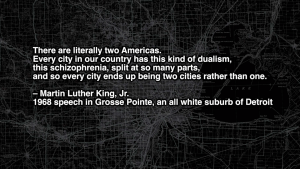[metaslider id=”205″]
Launch interactive dot density map for all decades.
In 1910, ninety-nine percent of Detroit residents were White. In 2010, eighty-three percent of Detroit was Black and only eleven percent was White. Detroit has reversed from a wealthy, White, and high-density city of homeowners to a poor and majority-Black city where most people do not own their own home. The Detroit region, too, has evolved from rolling farmland to mile after mile of strip malls and suburban homes on an ever-expanding crabgrass frontier. These changes are violent and visible to Detroit in the form of highways sliced through the urban fabric and thousands of abandoned factories, homes, and businesses photographed by ruins tourists.
Despite the ubiquitous images in the media of decline and abandonment in Detroit, we never get to see the invisible system of public policies and private investment decisions that did so much to produce this decline. This exhibit will render this system and its changes over time visible, from the redlining maps of the 1930s to the predatory mortgages and mass foreclosures of the 2000s and 2010s. All these policies produced decline through systematically draining investment from the central city to the suburbs and other regions.
These policies all involved race, though rarely in a straightforward way. Areas selected for disinvestment were almost invariably areas with a substantial (and often growing) Black population. These policies not only devastated the central city. They also made home ownership – the principal means of household saving and wealth for middle-income Americans – a difficult proposition for Black urban households and an even more profitable one for White suburban households. Thus they contributed strongly to the inequality of Black and White households that has reinforced racism.
Through computerized mapping and other representations, visitors will perceive the impact of these policies on the city – not just at the scale of the whole city but to be able to zoom down to their districts, neighborhoods, and even blocks. The exhibit will thus enable visitors to see their city in a new way.
Martin Luther King Jr.’s 1968 speech “The Other America” frames the themes of this exhibit.








